|
The ABCs of Sampler Collecting
By Carol Huber
Samplers and schoolgirl embroideries are one of the few decorative arts
collected today that were made away from home by non-professionals and not
intended to be purchased or sold. One of the least understood areas of
Americana, samplers were not highly collected until the middle of the 20th
century. Largely due to Bolton and Coe's hugely successful work, American
Samples (a listing of pieces owned by DAR members), samplers were discovered,
and collecting began at a very modest level.
Considered childish endeavors,
samplers were endearing, the messages often sweet, but the collecting world had
no clue about why, how or where they were made. The romantic notion that
samplers were stitched at mother's knee by candlelight was not dispelled until
the last quarter of the 20th century when scholars began researching and writing
about the young ladies' schools and academies found inscribed on many pieces. As
more and more samplers were published, groups with similarities appeared, and
attribution could be made to many based on style and composition. This
knowledge, along with genealogical information, allowed scholars to recognize
regional characteristics as well.
"Learn Your Duty And Do It, Lucy Ann
Smith, aged seven, 1812" was the inscription stitched on her small and simple
marking sampler. A requirement of all young girls, sampler making was a
necessity and an important part of female education. Although sampler making
dates to Egyptian times and served as decoration and pattern recording, the
samplers as we know them in America served a twofold purpose. The basic marking
samplers, consisting of alphabets and numbers with perhaps a simple verse and
modest border, were useful instruction for learning the fundamentals.
However,
it was a necessary technique for marking linens and clothing which were often
sent out to be laundered and needed to be rotated for equal wear. More intricate
and pictorial samplers were worked at day or boarding schools and were
considered an "accomplishment" to be brought home and proudly displayed. These
are the types of samplers that are highly collected today.
Sampler making was
consistently practiced by all girls from the time of the landing of the Pilgrims
to well into the mid-19th century. The earliest known American sampler was
stitched by Loara Standish, the only daughter of Miles and Barbara Standish,
between 1640 and 1650. (Loara and two of her six brothers died before reaching
adulthood.)
True to British form, early American samplers repeated what they
knew from the mother country and were long, narrow band samplers, displaying
rows of decorative motifs that could be copied for clothing or household
decoration.
This type of sampler was not intended to be framed, but rolled and
kept in the workbasket for referral. It is next to impossible to separate the
English from the Colonial pieces of the 17th century, and since most of these
are not signed or dated, they are almost always attributed to England. Good
examples can be purchased for $3,000-$10,000, while more elaborate pieces can
sell for over $100,000.
By the beginning of
the 18th century, samplers
became shorter, wider and more pictorial. They were intended to be framed,
and many were worked at expensive boarding schools. Early Boston
and Philadelphia pieces are highly desired and often wrought by daughters of
very prominent citizens. New England girls sometimes stitched a pictorial panel
in tent stitch at the bottom of their sampler, while Philadelphia girls
continued with band patterns well into the 1740s. Southern samplers occasionally
contain motifs copied from their northern neighbors as teachers migrated south
to open schools.
Schoolmistresses advertised extensively, and girls continued
the tradition of sampler making throughout the 18th and mid-19th centuries.
Teachers, and the schools and academies they created, have become an important
part of the overall sampler collectors knowledge base. It was the teacher and
not the student that designed samplers, and consequently, the similarities of
pieces allows us to group likenesses and attribute them to specific
regions.
Samplers exist by the thousands, and collectors should be aware of
the great range of pricing. The value of a sampler is not dependent on the date
or the maker, but rather on graphic appeal, location and condition. The cut off
date for most collectors is about 1850. After that date, samplers were less
likely to be taught as a part of school curriculum, but more as a hobby, and the
materials used became larger (i.e., wool verses silk and coarser linen). Simple
marking samplers are abundant and inexpensive, under $1,000, while extremely
graphic, colorful and important pieces are rare and can run into six-figure
price tags.
Fortunately, there are not many fakes on the market, but there
are some. Cute little, crooked lined, primitive-looking pieces worked on coarse
fabric are not period. Often dyed with tea, the background looks spotty and the
composition more like a child's drawing. Teachers in the 18th-19th centuries did
not employ this type of design or fabric.
In purchasing a sampler, the buyer
should first and foremost buy what is attractive to him or her, but always with
an eye to the visual appeal and condition of the work. Faded samplers will not
look brighter when hung on a wall and at a distance will look blank. Stains for
the most part will not come out, and color cannot be put back in. If there is no
central appeal, the eye will not focus on anything, and the sampler will simply
look busy and fussy. Most importantly, buy quality over quantity.
The market
for samplers has increased radically over the past 25 years. The publication of
numerous books and articles and private sales and auctions have aroused greater
interest, bringing ever more schoolgirl needlework to the market. A broad-based,
consistently growing market over so many years indicates a budding but permanent
market and not a collecting fad.
Although prices have risen considerably over
the past 25 years, samplers are still readily available and a good investment
value. Prices have been rising steadily, and there are more collectors. As in
every field, the best sell the most quickly and increase in value more
noticeably.
Some collectors find a focus for their collection a sampler
from every state or every school, samplers with animals, samplers within a time
range, or those with specific names. But whether focused or not, a collection of
samplers creates a warm and eye-catching display and provides a beautiful
connection to the past.
Stephen & Carol Huber of Old
Saybrook, Conn., have been dealing exclusively in schoolgirl embroideries for
more than thirty years. They can be contacted at 860-388- 6809
or hubers@AntiqueSamplers.com, or visit www.AntiqueSamplers.com. |
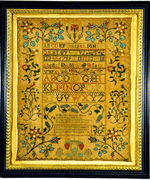
Jane Wilson's Sampler, Delaware, 1791, silk on linen, 14 3/4" x 12". The
elaborate floral border is vivid and well designed. Jane was 13 when she
stitched this piece.
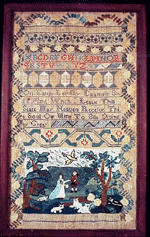
Sarah Doubt's Sampler, Boston, 1765, silk on linen, 19 7/8" x 11 3/4". New
England samplers often incorporated a canvaswork panel in the lower portion;
canvaswork pictures were very popular in the first half of the 18th c.
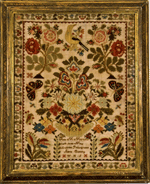
Ann M. Martin's Sampler, Pittsgrove, Salem County, N.J., May 1840. Ann's
sampler is an excellent example of the transition from early 19th c. samplers to
later work when designs became larger, and wool yarn replaced silk thread.
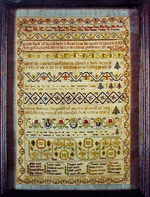
Ann Marsh's Sampler, Philadelphia, 1727, silk on linen, 15" x 11". Ann worked
this sampler under her mother's tutelage, who was a teacher in England. This
piece sold at Christie's several years ago for $300,000.
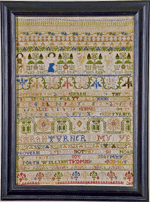
Sarah Turner's Band Sampler, England, 1720, silk on linen;
13 1/2" x 11".
The composition is a shorter version of a 17th century band sampler. Bands were
used to record patterns for clothing or household textiles.
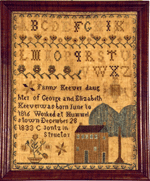
Fanny Keever's Sampler, Penn., 1833, silk on linen,
16 1/2" x 13 1/2".
Fanny stitched a remarkably informative sampler with birth date, parents'
names
and instructor. |